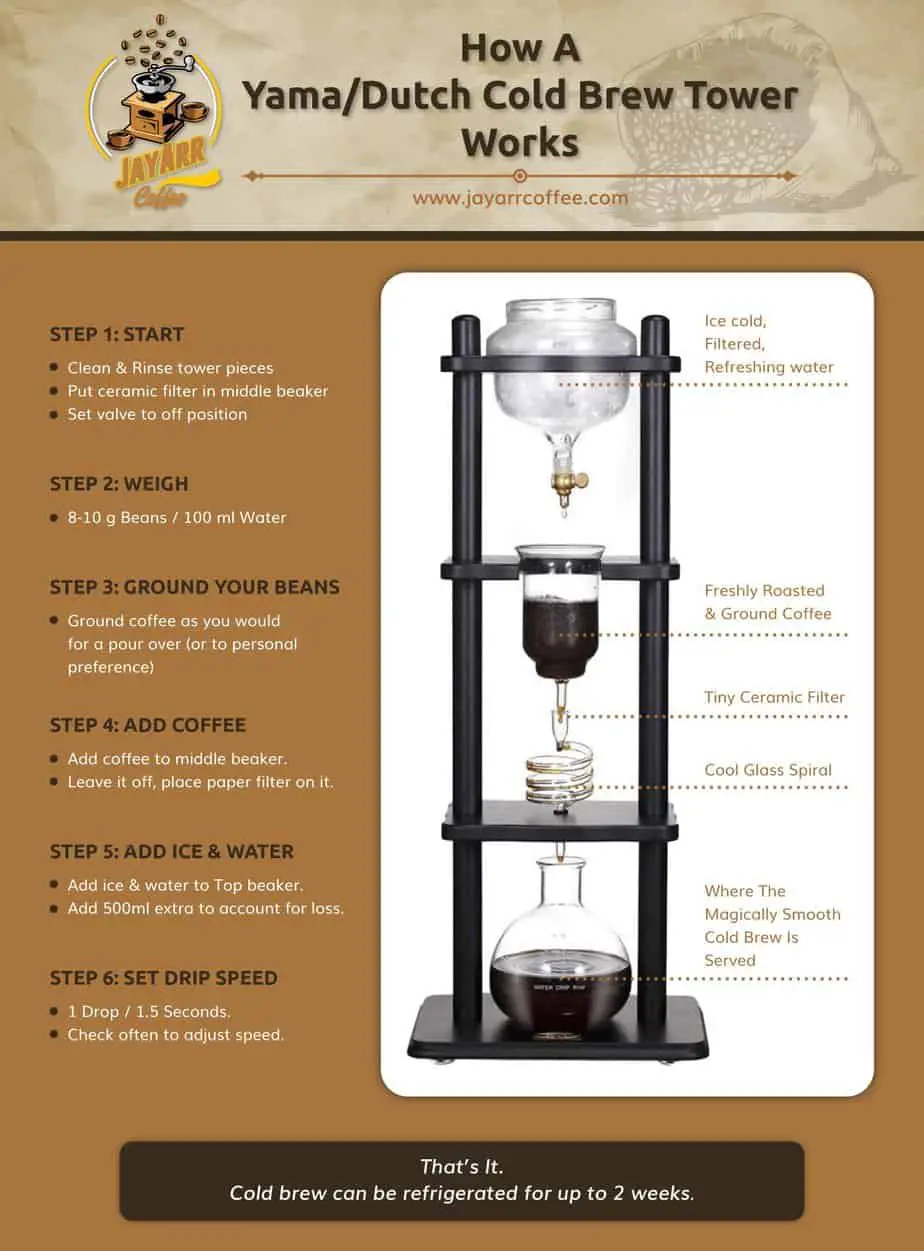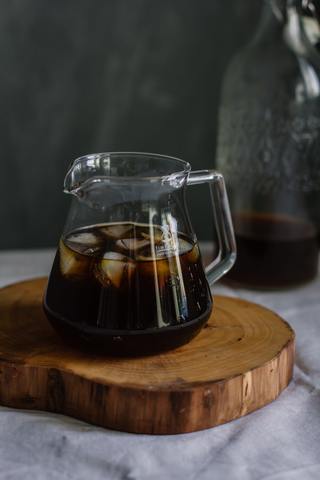In our article about Selecting the Right Cold Brew Roast, we noted the variety of methods and apparatuses that can be used to make cold brew. In this article, we’ll look at Dutch Brew specifically, as well as a particularly interesting apparatus: the Yama Tower.
Are Cold Brew and Dutch Brew the same?
Cold brew and Dutch brew are distinct from one another. While they both use cold, room temperature or iced water to prepare coffee, rather than boiling water, the method in which the grounds are soaked is different. Cold brew involves immersing the grounds completely in water that is then strained or filtered out later. Dutch brew, on the other hand, involves slowly dripping water. or letting ice melt, over the grounds. The difference in caffeine levels and taste adds further contrast to these two otherwise similar styles of coffee.
The History of Dutch Brew and the Yama Tower
To fully understand the Yama tower, let’s first explore the history of Kyoto coffee. The origins of coffee in Japan go back to Dutch visitors in the 17th century. During the 17th and 18th centuries, Dutch sailors developed the art of “Dutch” brew (hence the name!) entailing the use of cold brewing methods to allow coffee to be kept for long voyages overseas without spoiling. This style of coffee was then brought to Japan and Korea- two countries that preserved and kept the tradition alive long after it mostly disappeared elsewhere.
The Kyoto style of coffee brewing is usually of the Dutch variety. Over time, Japanese innovation, appreciation for avant-garde art, and a desire to further experiment in new coffee brewing methods helped to develop the glass tower from a basic design to a unique one. Yama produces produces fine quality versions of these glass towers.
What is a Yama Cold Brew Tower?
Many know of Kyoto style Slow Drip (or Yama cold brew, as it is often referred) as producing particularly excellent cold coffee. But what is so special about the eye-catching glass towers so commonly featured in Kyoto style brewing? And most importantly, how can one get their hands on one? You don’t have to travel to Japan to unlock the divine secrets of the Yama tower; all you have to do is read on for a few of these secrets!
How Do Dutch Brew or Yama Cold Brew Towers Work?
The design of these towers allows water to drip slowly through the apparatus onto the grounds at a particularly slow rate. The tower comprises several separate pieces. Ice is usually added to a reservoir at the top of the device and it is typically helpful to pour some water over the ice to get the flow started. Depending on the length of the tower and its intricacy, various coils and cylinders will be between the top and middle beaker to control the flow of water from the melted ice to a desired rate. The middle beaker holds the coffee grounds. Grounds generally should be between medium to fine, but some brewers of Dutch coffee typically opt for coarser grounds. More coils usually separate the middle beaker from a larger bottom reservoir. The slowly extracted coffee then accumulates in the large bottom reservoir.

The process of Dutch brewing is meant to be slow but it is also a convenient, easy and fun way to produce quality coffee. The brewing time for Dutch brew can range from 8 to 14 hours, and thus allowing the ice to drip slowly through the tower has many practical purposes. The resulting coffee beverage produced in this way may have a higher acidity compared to traditional cold brews, but the process also unlocks the more subtle notes that coffee normally gains when brewed at high temperatures. As we noted in our Cold Brew Guide, cold brewing often mutes these more subtle notes, trading them for a less acidic and richer flavor profile.
What Roast Level and Origin Should I Use for a Dutch Brew or Yama Tower?
Dutch brew is a great method to highlight fruitier flavors in coffee; light roasts are often the suggested roast type to try. The synergy of using a light roast in a Dutch brew creates a maximum number original flavors and notes as compared to the smoother, less acidic profile that occurs when using darker roasts when cold brewing. Some brewers suggest Ethiopian Yirgacheffe or particular vivacious varieties of Colombian beans for an incredible Dutch brew. However, any region that has naturally fruitier notes is ideal.

See our profile of Fruity Notes in Coffee for some extra detail on which roasts contain various fruity notes.
How much does a Yama tower cost?
Due to variance in intricacy (from ornate works of art to extremely basic) and the volume of coffee they can produce at one time, Yama towers vary significantly in price.
For a relatively basic Yama tower comprising of about 4 separate glass pieces and with a brewing capacity of 6-8 cups of coffee, the average price is about 200-300 USD. Meanwhile, for a larger, more intricate Yama tower that can brew as many as 25 cups of coffee at once, prices are likely closer to 400-500 USD or higher.
Yama produces quality glassware and is a brand name and product trusted for high quality. Yama towers can be purchased online, as well as the individual pieces for intrepid builders wanting to try their hand at assembling their own. While assembling a Yama tower at home may sound like a cheaper alternative, many of the items purchased separately will still cost between 170-250 USD.
Should I Get a Yama Tower?
The Yama tower is a perfect device for cafes or baristas wanting to feature a trendy and unique item in their establishment. The Yama tower will be a conversation starter, and is an indicator of a quality coffee establishment! For those who are interested in snagging a Yama tower for your home, ensure that you have a level, undisturbed location where it is safe from children and pets.
Prior to purchasing your own Yama tower, we recommend visiting local artisan cafes. Many cafes around the world have one or more of these devices at the ready for Dutch brew. Try Dutch brew first, and ensure you like it before purchasing your own tower!
Zen and the art of Yama tower maintenance
Yama towers can almost be considered home decor due to their striking and artful presence. However, the towers are specifically designed for precise brewing. The Yama tower comes equipped with nozzles and valves that allow you to set your drip speed and frequency. The suggested frequency is 1 drop every 1.5 seconds or so. This will allow your grounds to get a slow but regular drip flow and will result in an aromatic, rich and full bodied Dutch brew. Make sure to check your tower frequently to ensure that it is flowing nicely and is not getting too dry. Once your brewing is finished, you can store your Dutch brew in the refrigerator for up to two weeks. Ideally, storing your Dutch brew in a bottle with a tight lid is preferable to keep oxidation from occurring. Your Dutch brew will continue to evolve in flavor the longer it is kept, so try enjoying it after about 3 days of being kept cool in the refrigerator.

When it comes to cleaning your Yama tower, very hot water should not be used due to its damaging effects on the glass. We recommend disassembling the tower to assist with cleaning. Using pipe cleaners or other brushes can be effective, but all cleaners should be safe for glass. You can also use a mixture of salt and vinegar or lemon and water. This solution should be run through the tower at a moderate flow speed. Run a few more washes of clean water to cleanse the last of the solution out of the tubes and coils. Natural cleaning methods are advised in order to avoid chemical tastes leeching into your coffee.
The Yama tower, a true work of art!
Yama towers allow for a different experience from typical pour over or iced coffee that is vastly more customizable than traditional cold brew devices. Once you try this nuanced and one of a kind brewing style, you will understand the draw of Kyoto cafes.
Sources:
- “Coffee: What Is Kyoto-Style Cold Brew?” Breakfast With Nick, 28 Aug. 2015, www.breakfastwithnick.com/2014/05/20/coffee-what-is-kyoto-style-cold-brew/.
- “Cold Brew Towers.” Espresso Parts, www.espressoparts.com/top-brands/yama/cold-brew-towers.
- Nolan, Greg. “Kyoto-Style Slow Drip Coffee.” I Need Coffee, 25 June 2018, ineedcoffee.com/kyoto-style-slow-drip-coffee/.
- “Yama Cold Brew Tower 25 Cups.” Barista, www.barista-shop.gr/en/cold-brew/875-yama-cold-brew-tower-25-cup.html.
- “Yama Cold Brew.” Esselon Coffee, www.esseloncoffee.com/how-to-brew/yama/.
- “茶系列.” 亞美耐熱玻璃股份有限公司, www.yamaglass.com.tw/.
